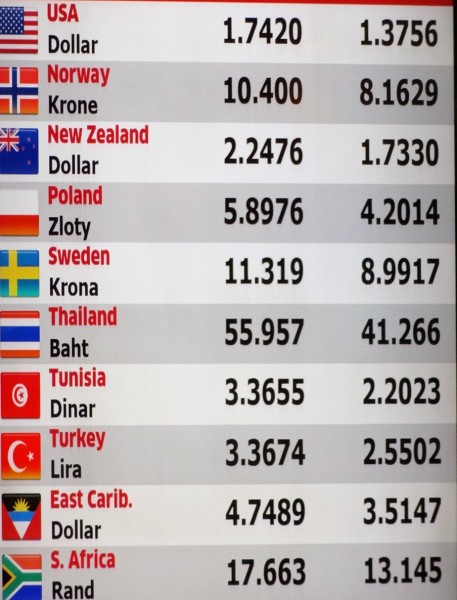 According to latest evidence from the Bank for International Settlements, in April 2013 some £3.2 trillion ($5.3 trillion) of foreign exchange was traded daily on global foreign exchange (forex) markets. About 40% of forex dealing goes through trading rooms in London. This market is highly profitable for the UK economy. But all is not well with the way people trade. There is a scandal about rate fixing.
According to latest evidence from the Bank for International Settlements, in April 2013 some £3.2 trillion ($5.3 trillion) of foreign exchange was traded daily on global foreign exchange (forex) markets. About 40% of forex dealing goes through trading rooms in London. This market is highly profitable for the UK economy. But all is not well with the way people trade. There is a scandal about rate fixing.
Exchange rates on the forex market are freely determined by demand and supply and fluctuate second by second, 24 hours a day, except for weekends. Nevertheless, once a day rates are fixed for certain trades. At 4pm GMT a set of reference rates is set for corporate customers by banks and other traders. The rates are set at the free market average over the one minute from 16:00 to 16:01. The allegation is that banks have been colluding, through text messaging and chat rooms, to manipulate the market over that one minute.
Since the early summer of 2013, the Financial Conduct Authority (FCA) in the UK, along with counterparts in the USA, Switzerland, Hong Kong and elsewhere, has been looking into these allegations. Last week (4/3/14), the Bank of England suspended a member of its staff as part of its own investigation into potential rigging of the foreign exchange market. The allegation is not that the staff member(s) were involved in the rigging but that they might have known about it. The Bank said that, “An oversight committee will lead further investigations into whether bank officials were involved in forex market manipulation or were aware of manipulation, or at least the potential for such manipulation.”
The Bank said that, “An oversight committee will lead further investigations into whether bank officials were involved in forex market manipulation or were aware of manipulation, or at least the potential for such manipulation.”
Meanwhile, the House of Commons Treasury Select Committee has been questioning Bank of England staff, including the governor, Mark Carney, about the scandal. Speaking to the Committee, Martin Wheatley, head of the FCA said that the investigation over rigging had been extended to 10 banks and that the allegations are every bit as bad as they have been with Libor.
Forex rigging ‘as serious as’ Libor scandal: Carney Yahoo News, Roland Jackson (11/2/14)
Forex manipulation: How it worked HITC (Here Is The City), Catherine Boyle (11/3/14)
Bank of England Chief Grilled Over Forex Scandal ABC News, Danica Kirka (11/3/14)
Carney Faces Grilling as Currency Scandal Snares BOE Bloomberg, Scott Hamilton and Suzi Ring (10/3/14)
UK financial body urges quick action over foreign exchange ‘fixing’ Reuters, Huw Jones (11/3/14)
Timeline -The FX “fixing” scandal Reuters, Jamie McGeever (11/3/14)
Forex in the spotlight Financial Times (16/2/14)
Forex scandal: What is that all about? BBC News (11/3/14)
 Bank of England in shake-up after rate manipulation criticism BBC News (11/3/14)
Bank of England in shake-up after rate manipulation criticism BBC News (11/3/14)
 Mark Carney faces Forex questions from MPs BBC News, Hugh Pym (11/3/14)
Mark Carney faces Forex questions from MPs BBC News, Hugh Pym (11/3/14)
Bank of England’s Paul Fisher: ‘It’s not our job to go hunting for market wrongdoing’ Independent, Russell Lynch , Ben Chu (11/3/14)
Questions
- For what reasons would sterling appreciate against the dollar?
- Most of forex trading is for speculative purposes, rather than for financing trade or investment. Why is this and does it benefit international trade?
- If foreign exchange rates fluctuate, is it not a good thing that banks collude to agree the 4pm fixed rate? Explain.
- What was the Libor scandal? Why are some people arguing that the current forex scandal is worse?
- What can the FCA do to prevent collusion over exchange rates?
 World markets were taken by surprise by a large rise in Turkish interest rates on 28/1/14. In an attempt to combat a falling lira and rising inflation, the Turkish central bank raised its overnight lending rate from 7.75% to 12%. Following the decision, the lira appreciated by over 3%.
World markets were taken by surprise by a large rise in Turkish interest rates on 28/1/14. In an attempt to combat a falling lira and rising inflation, the Turkish central bank raised its overnight lending rate from 7.75% to 12%. Following the decision, the lira appreciated by over 3%.
Since the start of this year, the Turkish lira had depreciated by 7.1% and since the start of 2013 by 22.8%. Along with the currencies of several other emerging economies, such as India and Brazil, speculators had been selling the Turkish currency. This has been triggered by worries that the Fed’s tapering off its quantitative easing programme would lead to a fall, and perhaps reversal, of the inflow of finance into these countries; in the worst-case scenario it could lead to substantial capital flight.
Consumer price inflation in Turkey is currently 7.4%, up from 6.2% a year ago. The central bank, in a statement issued alongside the interest rate rise, said that it would continue with a tight monetary policy until the inflation outlook showed a clear improvement.
policy until the inflation outlook showed a clear improvement.
The Turkish Prime Minister, Tayyip Erdogan, has been opposed to rises in interest rates, fearing that the dampening effect on aggregate demand would reduce economic growth, which, as the chart shows, has been recovering recently (click here for a PowerPoint of the chart). A slowing of growth could damage his prospects in forthcoming elections.
World stock markets, however, rallied on the news, seeing the rise in interest rates as a symbolic step in emerging countries stemming outflows of capital.
Articles
Turkey raises interest from 7.75pc to 12pc The Telegraph (28/1/14)
Emerging markets forced to tighten by US and Chinese monetary superpowers The Telegraph, Ambrose Evans-Pritchard (28/1/14)
Turkey Gets Aggressive on Rates The Wall Street Journal, Joe Parkinson (28/1/14)
Turkish central bank raises lending rate to 12% BBC News (28/1/14)
Asian stock markets stage relief rally after Turkey rate rise BBC news (29/1/14)
Turkey raises rates to halt lira’s slide Financial Times, Daniel Dombey (29/1/14)
Turkey Rate Increase Stems Lira Drop as Basci Defies Erdogan Bloomberg Businessweek, Onur Ant and Taylan Bilgic (29/1/14)
Fragile economies under pressure as recovery prompts capital flight The Observer, Angela Monaghan (2/2/14)
Data
Main Economic Indicators (including Turkish data) OECD
Data on Turkey, World Economic Outlook database IMF
Turkey price indices Central Bank of the Republic of Turkey
Questions
- Why did the Turkish central bank decide to raise interest rates by such a large amount?
- Why has the Turkish lira been depreciating so much over the past few months? How has this been linked to changes in Turkey’s balance of payments and what parts of the balance of payments account have been affected?
- Why did global stock markets rally on the news from Turkey?
- What will be the impact of the central bank’s actions on (a) inflation; (b) economic growth?
- How has the USA’s quantitative easing programme affected developing countries?
 Your favourite chocolate bar or your drink of hot chocolate could soon be much dearer. Since March, the price of cocoa has risen by 34% and much of this increase remains to be passed on to the consumer. The price of cocoa butter is up 70% since the beginning of the year.
Your favourite chocolate bar or your drink of hot chocolate could soon be much dearer. Since March, the price of cocoa has risen by 34% and much of this increase remains to be passed on to the consumer. The price of cocoa butter is up 70% since the beginning of the year.
On the demand side, sales of luxury cocoa-rich chocolate and hot chocolate have been rising and chocolate manufacturers, with relatively low forward purchases of cocoa, are likely to have to buy more in spot markets. What is more, there is growing speculative demand as traders anticipate higher prices to come.
On the supply side, dry weather in West Africa, where 70% of cocoa beans are produced, has led to a fall in output. Estimates suggest that cocoa production in the 12 months to end-September 2013 will be 2.7% down on the previous 12 months. Supply is expected to be 60,000 tonnes less than demand, resulting in a fall in stocks from 1,833,000 to 1,773,000.
end-September 2013 will be 2.7% down on the previous 12 months. Supply is expected to be 60,000 tonnes less than demand, resulting in a fall in stocks from 1,833,000 to 1,773,000.
The following articles look at the ‘crisis’ for chocoholics and at the market conditions that lie behind it.
Articles
Craving for a chocolate fix? Prepare to pay more Reuters, Lewa Pardomuan and Marcy Nicholson (15/9/13)
Hot chocolate demand sends cocoa prices soaring Financial Times, Emiko Terazono (15/10/13)
Price of chocolate ‘to triple’ The Telegraph (8/10/13)
Paying more for chocolate? You will be CNN Money, Alanna Petroff (14/10/13)
Chocolate Prices Soar in Dark Turn The Wall Street Journal, Leslie Josephs and Neena Rai (22/9/13)
 Chocolate prices could increase as cocoa costs soar BBC News, Nigel Cassidy (21/10/13)
Chocolate prices could increase as cocoa costs soar BBC News, Nigel Cassidy (21/10/13)
… and on a lighter note: Rising Prices Signal A ‘Devastating’ Global Chocolate Crisis: Should Government Act To Save Us? Forbes, Doug Bandow (14/10/13)
Data
Cocoa beans: monthly price Index Mundi
ICCO daily prices of cocoa beans International Cocoa Organization (click on calendar to select month)
Production of cocoa beans International Cocoa Organization (click on Statistical Data links in right hand panel
Monthly review of the market International Cocoa Organization
Questions
- What happened to cocoa prices from January 2009 to March 2013? Explain this movement in prices.
- Why have cocoa prices risen so much since March 2013? Illustrate your analysis with a supply and demand diagram.
- If the demand for luxury chocolate fluctuates considerably with the state of the business cycle, what does this suggest about the income elasticity of demand for luxury chocolate?
- How would you establish whether or not cheap chocolate is an inferior good?
- If cocoa prices rise by 34%, what determines the percentage by which a bar of chocolate will rise?
- What determines the difference between cocoa futures and spot prices?
- How realistically could government intervention improve the lot of chocoholics?
 As we saw in the news item The difficult exit from cheap money, central banks around the world have been operating an extremely loose monetary policy since the beginning of 2009. Their interest rates have been close to zero and trillions of dollars of extra money has been injected into the world economy through various programmes of quantitative easing.
As we saw in the news item The difficult exit from cheap money, central banks around the world have been operating an extremely loose monetary policy since the beginning of 2009. Their interest rates have been close to zero and trillions of dollars of extra money has been injected into the world economy through various programmes of quantitative easing.
For the past few months the Federal Reserve has been purchasing bonds under its most recent programme dubbed QE3, and thereby increasing narrow money, by $85 billion per month. Since the start of its QE programme in 2009, it has pumped around $2.8 trillion of extra money into the US and world economies. This huge increase in money supply has boosted the demand for assets worldwide and world stock markets have risen. Much of the money has flowed into developing countries, such as India, and has acted as a boost to their economies.
 Once the US economy is growing strongly again, the aim is to taper off, and ultimately end or even reverse, the QE programme. It was expected that the Fed would decide to start this tapering off process at its meeting on 18 September – perhaps reducing bond purchases initially by some $10 billion. (Note that this would still be an increase in money supply, just a slightly smaller one.) Over the past few days, US bond prices have been falling (and yields increasing) in anticipation of such a move.
Once the US economy is growing strongly again, the aim is to taper off, and ultimately end or even reverse, the QE programme. It was expected that the Fed would decide to start this tapering off process at its meeting on 18 September – perhaps reducing bond purchases initially by some $10 billion. (Note that this would still be an increase in money supply, just a slightly smaller one.) Over the past few days, US bond prices have been falling (and yields increasing) in anticipation of such a move.
As it turned out, the Fed decided to delay tapering off. It will continue with its assets purchase programme of $85 billion per month for the time being. The reason given was that the US economy was still too fragile and needed the monthly injections of money to stay at the current level.
Normally it might be expected that the announcement of a more fragile recovery would cause the US stock market, and others worldwide, to fall. In fact the opposite occurred, with investors relieved that the extra money, which allows extra asset purchases, would continue at the same rate.
But this then raises the question of just what will be the effect when tapering off does actually occur. Will stock markets then go into a tailspin? Or will they merely stop rising so fast. That depends very much on the role of speculation.
Webcasts
 Bernanke’s Own Words on Asset Purchases, Economy Bloomberg (18/9/13)
Bernanke’s Own Words on Asset Purchases, Economy Bloomberg (18/9/13)
 Bernanke: Fed to delay bond tapering PBS Newshour on YouTube (full speech plus questions) (18/9/13)
Bernanke: Fed to delay bond tapering PBS Newshour on YouTube (full speech plus questions) (18/9/13)
 No tapering announced by Fed CNBC on Yahoo Finance (18/9/113)
No tapering announced by Fed CNBC on Yahoo Finance (18/9/113)
 The impact of US stimulus moves at home and abroad BBC News, Stephanie Flanders (18/9/13)
The impact of US stimulus moves at home and abroad BBC News, Stephanie Flanders (18/9/13)
 Is the upturn reaching Americans? BBC World, Stephanie Flanders (17/9/13)
Is the upturn reaching Americans? BBC World, Stephanie Flanders (17/9/13)
 Shares hit high as Federal Reserve maintains stimulus BBC News, Stephanie Flanders (18/9/13)
Shares hit high as Federal Reserve maintains stimulus BBC News, Stephanie Flanders (18/9/13)
 US Fed decision to delay tapering was a relief ET Now (India), Bimal Jalan (19/9/13)
US Fed decision to delay tapering was a relief ET Now (India), Bimal Jalan (19/9/13)
Articles
Federal Reserve surprises markets by delaying QE tapering The Telegraph, Katherine Rushton (18/9/13)
Federal Reserve delays QE tapering: the full statement The Telegraph (18/9/13)
Q&A: What is tapering? BBC News (18/9/13)
Fed delay is no reason to celebrate The Guardian, Larry Elliott (19/9/13)
Federal Reserve tapering decision has baffled the markets The Guardian, Larry Elliott (19/9/13)
Taper tiger The Economist (21/9/13)
Everything You Need to Know About the Fed’s Decision Not to Taper QE3 The Atlantic, Matthew O’Brien (18/9/13)
Fed’s dovish turn leaves Wall Street economists mulling taper timing: poll Reuters, Chris Reese (18/9/13)
Good news and bad news from the Fed BBC News, Stephanie Flanders (19/9/13)
Is the Fed frightened of its shadow? BBC News, Robert Peston (19/9/13)
The Federal Reserve and Janet Yellen face a tough task with insufficient tools The Guardian, Mohamed A. El-Erian (14/10/13)
Questions
- Why might a slowing down in the increase in US money supply cause asset prices to fall, rather than merely to rise less quickly?
- Why has the US QE programme led to a rise in asset prices overseas?
- Distinguish between stabilising and destabilising speculation. Which type of speculation has been occurring as a result of the US QE programme?
- How has QE affected unemployment in the UK and USA? How is the participation rate and the flexibility of labour markets relevant to the answer?
- Explain the following two statements by Stephanie Flanders and Robert Peston respectively. “The market conditions argument has a circularity to it: talk of tapering leads to higher market rates, which in turn puts the taper itself on hold.” “The Fed simply hinting that less money would be created, means that there will be no reduction in the amount of money created (for now at least).”
- Why have US long-term interest rates, including mortgage rates, risen since May of this year?
- What impact have higher US long-term interest rates had on economies in the developing world? Explain.
 Tight fiscal policies are being pursued in many countries to deal with high public-sector deficits that resulted from the deep recession of 2008/9. This has put the main onus on monetary policy as the means of stimulating recovery. As a result we have seen record low interest rates around the world, set at only slightly above zero in the main industrialised countries for the past 4½ years. In addition, there have been large increases in narrow money as a result of massive programmes of quantitative easing.
Tight fiscal policies are being pursued in many countries to deal with high public-sector deficits that resulted from the deep recession of 2008/9. This has put the main onus on monetary policy as the means of stimulating recovery. As a result we have seen record low interest rates around the world, set at only slightly above zero in the main industrialised countries for the past 4½ years. In addition, there have been large increases in narrow money as a result of massive programmes of quantitative easing.
Yet recovery remains fragile in many countries, including the UK and much of the rest of Europe. And a new problem has been worries by potential investors that loose monetary policy may be soon coming to an end. As the June blog The difficult exit from cheap money pointed out:
The US economy has been showing stronger growth in recent months and, as a result, the Fed has indicated that it may soon have to begin tightening monetary policy. It is not doing so yet, nor are other central banks, but the concern that this may happen in the medium term has been enough to persuade many investors that stock markets are likely to fall as money eventually becomes tighter. Given the high degree of speculation on stock markets, this has led to a large-scale selling of shares as investors try to ‘get ahead of the curve’.
Central banks have responded with a new approach to monetary policy. This is known as ‘forward guidance’. The idea is to manage expectations by saying what the central bank will do over the coming months.
The USA was the first to pursue this approach. In September 2012 the Fed committed to bond purchase of $40bn per month (increased to $85bn per month in January 2013) for the foreseeable future; and record low interest rates of between 0% and 0.25% would continue. Indeed, as pointed out above, it was the ‘guidance’ last month that such a policy would be tapered off at some point, that sent stock markets falling in June.
The Fed has since revised its guidance. On 10 July, Ben Bernanke, the Fed Chairman said that monetary policy would not be tightened for the foreseeable future. With fiscal policy having been tightened, QE would continue and interest rates would not be raised until unemployment had fallen to 6.5%.
Japan has been issuing forward guidance since last December. Its declared aim has been to lower the exchange rate and raise inflation. It would take whatever fiscal and monetary policies were deemed necessary to achieve this (see A J-curve for Japan? and Japan’s three arrows).
Then on 4 July both the Bank of England and the ECB adopted forward guidance too. Worried that growth in the US economy would lead to an end to loose monetary policy before too long and that this would drive up interest rates worldwide, both central banks committed to keeping interest rates low for an extended period of time. Indeed, the ECB declared that the next movement in interest rates would more likely be down than up. Mario Draghi, the ECB president said that the ending of loose monetary policy is ‘very distant’.
The effect of this forward guidance has been to boost stock markets again. The hope is that by managing expectations in this way, the real economy will be affected too, with increased confidence leading to higher investment and faster economic growth.
 Update (8/8/13)
Update (8/8/13)
With the publication of its August 2013 Inflation Report, the Bank of England clarified its approach to forward guidance. It was announced that Bank Rate would stay at the current historically low level of 0.5% ‘at least until the Labour Force Survey headline measure of unemployment has fallen to a threshold of 7%’. In his Inflation Report Press Conference opening remarks, Mark Carney, Governor of the Bank of England, also stated that:
While the unemployment rate remains above 7%, the MPC stands ready to undertake further asset purchases if further stimulus is warranted. But until the unemployment threshold is reached the MPC intends not to reduce the stock of asset purchases from the current £375 billion.
Nevertheless, the Bank reserved the right to abondon this undertaking under cirtain circumstances. As Mark Carney put it:
The Bank of England’s unwavering commitment to price stability and financial stability is such that this threshold guidance will cease to apply if material risks to either are judged to have arisen. In that event, the unemployment threshold would be ‘knocked out’. The guidance will remain in place only if, in the MPC’s view, CPI inflation 18 to 24 months ahead is more likely than not to be below 2.5%, medium-term inflation expectations remain sufficiently well anchored, and the FPC has not judged that the stance of monetary policy poses a significant threat to financial stability that cannot otherwise be contained through the considerable supervisory and regulatory policy tools of the various authorities. The two inflation knockouts ensure that the guidance remains fully consistent with our primary objective of price stability. The financial stability knockout takes full advantage of the new institutional structure at the Bank of England, ensuring that monetary and macroprudential policies coordinate to support a sustainable recovery. The knock-outs would not necessarily trigger an increase in Bank Rate – they would instead be a prompt for the MPC to reconsider the appropriate stance of policy.
Similarly, it is important to be clear that Bank Rate will not automatically be increased when the unemployment threshold is reached. Nor is 7% a target for unemployment. The rate of unemployment consistent with medium-term price stability – a rate that monetary policy can do little to affect – is likely to be lower than this. So 7% is merely a ‘way station’ at which the MPC will reassess the state of the economy, the progress of the economic recovery, and, in that context, the appropriate stance of monetary policy.
The articles in the updated section below consider the implications of this forward guidance and the caveat that the undertaking might be abondoned in certain circumstances.
Articles
Q&A: What is ‘forward guidance’ BBC News, Laurence Knight (4/7/13)
Forward guidance crosses the Atlantic The Economist, P.W. (4/7/13)
ECB has no plans to exit loose policies, says Benoit Coeure The Telegraph, Szu Ping Chan (25/6/13)
ECB issues unprecedented forward guidance The Telegraph, Denise Roland (4/7/13)
Independence day for central banks BBC News, Stephanie Flanders (4/7/13)
The Monetary Policy Committee’s search for guidance BBC News, Stephanie Flanders (16/7/13)
The Monetary Policy Committee’s search for guidance (II) BBC News, Stephanie Flanders (17/7/13)
Bank of England surprise statement sends markets up and sterling tumbling The Guardian, Jill Treanor and Angela Monaghan (4/7/13)
Forward guidance only works if you do it right Financial Times, Wolfgang Münchau (7/7/13)
Fed’s Forward Guidance Failing to Deliver Wall Street Journal, Nick Hastings (15/7/13)
Talking Point: Thoughts on ECB forward guidance Financial Times, Dave Shellock (11/7/13)
Forward guidance in the UK is likely to fail as the Fed taper approaches City A.M., Peter Warburton (12/7/13)
Forward guidance more than passing fashion for central banks Reuters, Sakari Suoninen (11/7/13)
Markets await Mark Carney’s ‘forward guidance’ The Guardian, Heather Stewart (17/7/13)
Beware Guidance The Economist, George Buckley (25/7/13)
Articles for update
The watered down version of Forward Guidance Reuters, Kathleen Brooks (8/8/13)
Clarity Versus Flexibility at the Bank of England Bloomberg (7/8/13)
Mark Carney’s guidance leaves financial markets feeling lost Independent, Ben Chu (8/8/13)
Bank links interest rates to unemployment target BBC News (7/8/13)
Mark Carney says forward guidance should boost economy BBC News (8/8/13)
The Bank’s new guidance BBC News, Stephanie Flanders (7/8/13)
Uncertainty over BoE guidance lifts sterling to 7-week peak Reuters, Spriha Srivastava (8/8/13)
Bank of England’s guidance is clear, say most economists: Poll The Economic Times (8/8/13)
Britain’s economy: How is it really doing? The Economist (10/8/13)
Markets give thumbs down to Mark Carney’s latest push on forward guidance The Guardian, Larry Elliott (28/8/13)
Carney’s guidance on guidance BBC News, Stephanie Flanders (28/8/13)
Webcasts and podcasts for update
 Inflation Report Press Conference Bank of England (7/8/13)
Inflation Report Press Conference Bank of England (7/8/13)
 Interest rates to be held until unemployment drops to 7% BBC News, Extracts of Statement by Mark Carney, Governor of the Band of England (7/8/13)
Interest rates to be held until unemployment drops to 7% BBC News, Extracts of Statement by Mark Carney, Governor of the Band of England (7/8/13)
 Bank of England links rates to unemployment target BBC News (7/8/13)
Bank of England links rates to unemployment target BBC News (7/8/13)
 Mark Carney: Financial institutions ‘have to change culture’ BBC Today Programme (8/8/13)
Mark Carney: Financial institutions ‘have to change culture’ BBC Today Programme (8/8/13)
 Bank of England’s Mark Carney announces rates held BBC News. John Moylan (7/8/13)
Bank of England’s Mark Carney announces rates held BBC News. John Moylan (7/8/13)
Central Bank Statements and Speeches
How does forward guidance about the Federal Reserve’s target for the federal funds rate support the economic recovery? Federal Reserve (19/6/13)
Remit for the Monetary Policy Committee HM Treasury (20/3/13)
Bank of England maintains Bank Rate at 0.5% and the size of the Asset Purchase Programme at £375 billion Bank of England (4/7/13)
Monthly Bulletin ECB (see Box 1) (July 2013)
Inflation Report Press Conference: Opening remarks by the Governor Bank of England (7/8/13)
MPC document on Monetary policy trade-offs and forward guidance Bank of England (7/8/13)
Monetary policy and forward guidance in the UK Bank of England, David Miles (24/9/13)
Monetary strategy and prospects Bank of England, Paul Tucker (24/9/13)
Questions
- Is forward guidance a ‘rules-based’ or ‘discretion-based’ approach to monetary policy?
- Is it possible to provide forward guidance while at the same time pursuing an inflation target?
- If people know that central banks are trying to manage expectations, will this help or hinder central banks?
- Does the adoption of forward guidance by the Bank of England and ECB make them more or less dependent on the Fed’s policy?
- Why may forward guidance be a more effective means of controlling interest rates on long-term bonds (and other long-term rates too) than the traditional policy of setting the repo rate on a month-by-month basis?
- What will determine the likely success of forward guidance in determining long-term bond rates?
- Is forward guidance likely to make stock market speculation less destabilising?
- Is what ways is the ‘threshold guidance’ by the Bank of England likely to make the current expansionary stance of monetary policy more effective?
- Is 7% the ‘natural rate of unemployment’? Explain your reasoning.
 According to latest evidence from the Bank for International Settlements, in April 2013 some £3.2 trillion ($5.3 trillion) of foreign exchange was traded daily on global foreign exchange (forex) markets. About 40% of forex dealing goes through trading rooms in London. This market is highly profitable for the UK economy. But all is not well with the way people trade. There is a scandal about rate fixing.
According to latest evidence from the Bank for International Settlements, in April 2013 some £3.2 trillion ($5.3 trillion) of foreign exchange was traded daily on global foreign exchange (forex) markets. About 40% of forex dealing goes through trading rooms in London. This market is highly profitable for the UK economy. But all is not well with the way people trade. There is a scandal about rate fixing. The Bank said that, “An oversight committee will lead further investigations into whether bank officials were involved in forex market manipulation or were aware of manipulation, or at least the potential for such manipulation.”
The Bank said that, “An oversight committee will lead further investigations into whether bank officials were involved in forex market manipulation or were aware of manipulation, or at least the potential for such manipulation.” Bank of England in shake-up after rate manipulation criticism BBC News (11/3/14)
Bank of England in shake-up after rate manipulation criticism BBC News (11/3/14) Mark Carney faces Forex questions from MPs BBC News, Hugh Pym (11/3/14)
Mark Carney faces Forex questions from MPs BBC News, Hugh Pym (11/3/14)






